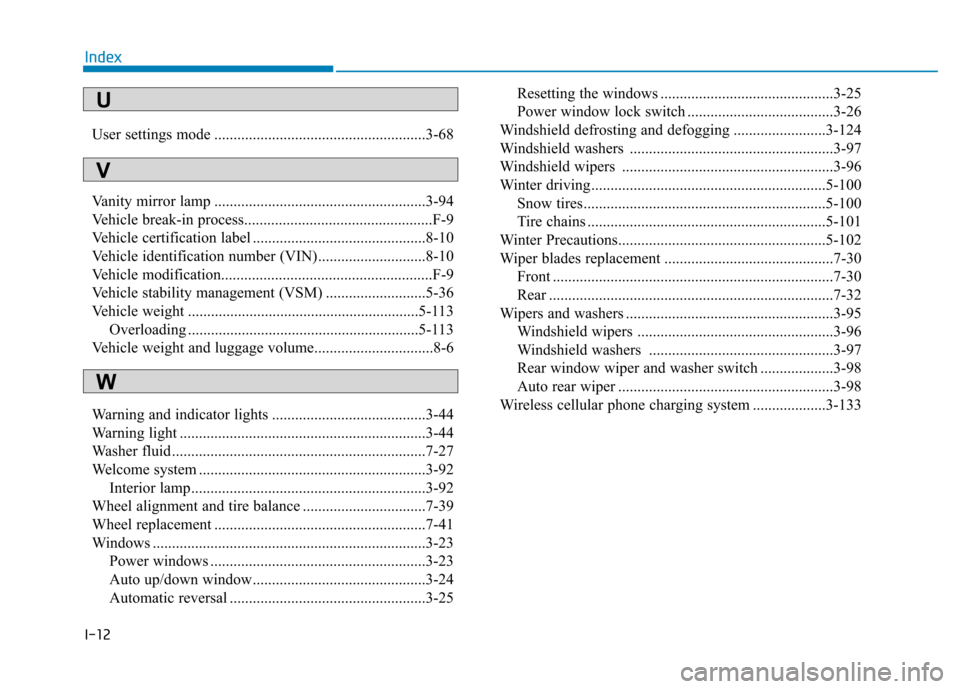2018 Hyundai Kona winter tires
[x] Cancel search: winter tiresPage 354 of 523

5-100
Driving your vehicle
The severe weather conditions of
winter quickly wear out tires and
cause other problems. To minimize
winter driving problems, you should
take the following suggestions:Information
Information for Snow Tires and Tire
Chains in the national language
(Bulgarian, Hungarian, Icelandic,
Polish) is provided in the Appendix.Snow or icy conditions
You need to keep sufficient distance
between your vehicle and the vehicle
in front of you.
Apply the brakes gently. Speeding,
rapid acceleration, sudden brake
applications, and sharp turns are
potentially very hazardous practices.
During deceleration, use engine
braking to the fullest extent. Sudden
brake applications on snowy or icy
roads may cause skids to occur.
To drive your vehicle in deep snow, it
may be necessary to use snow tires
or to install tire chains on your tires.
Always carry emergency equipment.
Some of the items you may want to
carry include tire chains, tow straps
or chains, a flashlight, emergency
flares, sand, a shovel, jumper cables,
a window scraper, gloves, ground
cloth, coveralls, a blanket, etc.
Snow tires
If you mount snow tires on your vehi-
cle, make sure to use radial tires of
the same size and load range as the
original tires. Mount snow tires on all
four wheels to balance your vehicle’s
handling in all weather conditions.
The traction provided by snow tires
on dry roads may not be as high as
your vehicle's original equipment
tires. Check with the tire dealer for
maximum speed recommendations.
Information
Do not install studded tires without first
checking local and municipal regula-
tions for possible restrictions against
their use.
i
i
WW IINN TTEERR DD RRIIVV IINN GG
Snow tires should be equivalent
in size and type to the vehicle's
standard tires. Otherwise, the
safety and handling of your vehi-
cle may be adversely affected.
WARNING
Page 378 of 523

6-11
What to do in an emergency
6
TPMS (Tire Pressure Monitoring System)malfunction indicator
The TPMS malfunction indicator will
illuminate after it blinks for approxi-
mately one minute when there is a
problem with the Tire Pressure
Monitoring System. If the system is
able to correctly detect an under
inflation warning at the same time as
system failure then it will illuminate
the TPMS malfunction indicator.
We recommend that the system be
checked by an authorized HYUNDAI
dealer.
In winter or cold weather, the
low tire pressure telltale may beilluminated if the tire pressurewas adjusted to the recom-mended tire inflation pressure
in warm weather. It does not
mean your TPMS is malfunc-tioning because the decreased
temperature leads to a propor-
tional lowering of tire pressure.
When you drive your vehicle
from a warm area to a cold area
or from a cold area to a warm
area, or the outside temperature
is greatly higher or lower, you
should check the tire inflationpressure and adjust the tires tothe recommended tire inflation
pressure.
CAUTION
Low pressure damage
Significantly low tire pressure
makes the vehicle unstable and
can contribute to loss of vehicle
control and increased brakingdistances.
Continued driving on low pres- sure tires can cause the tires to
overheat and fail.
WARNING
The TPMS malfunction indica-
tor may be illuminated if the
vehicle is moving around
electric power supply cables
or radios transmitter such as
at police stations, government
and public offices, broadcast-
ing stations, military installa-
tions, airports, or transmitting
towers, etc. This can interferewith normal operation of theTire Pressure MonitoringSystem (TPMS).
The TPMS malfunction indica-
tor may illuminate if snow
chains or some separately
purchased devices such as
notebook computers, mobile
charger, remote starter, navi-
gation etc. are used in the
vehicle. This can interfere with
normal operation of the TirePressure Monitoring System(TPMS).
CAUTION
Page 384 of 523

6-17
What to do in an emergency
6
The spare tire is not equipped with
a tire pressure sensor.
TPMS (Tire Pressure Monitoring System)malfunction indicator
The TPMS malfunction indicator will
illuminate after it blinks for approxi-
mately one minute when there is a
problem with the Tire Pressure
Monitoring System.
We recommend that the system be
checked by an authorized HYUNDAI
dealer. If there is a malfunction with the
TPMS, the low tire pressure posi-
tion telltale will not be displayed
even though the vehicle has an
under-inflated tire.
NOTICE
NOTICE
In winter or cold weather, the
low tire pressure telltale mayilluminate if the tire pressurewas adjusted to the recom-mended tire inflation pressure
in warm weather. It does not
mean your TPMS is malfunc-tioning because the decreased
temperature leads to a lowering
of tire pressure.
When you drive your vehicle
from a warm area to a cold area
or from a cold area to a warm
area, or the outside temperature
is higher or lower, you should
check the tire inflation pressureand adjust the tires to the rec-ommended tire inflation pres-
sure.
CAUTION
Low pressure damage
Significantly low tire pressure
makes the vehicle unstable and
can contribute to loss of vehicle
control and increased brakingdistances.
Continued driving on low pres- sure tires can cause the tires to
overheat and fail.
WARNING
Page 523 of 523

I-12User settings mode .......................................................3-68
Vanity mirror lamp .......................................................3-94
Vehicle break-in process.................................................F-9
Vehicle certification label .............................................8-10
Vehicle identification number (VIN)............................8-10
Vehicle modification.......................................................F-9
Vehicle stability management (VSM) ..........................5-36
Vehicle weight ............................................................5-113
Overloading ............................................................5-113
Vehicle weight and luggage volume...............................8-6
Warning and indicator lights ........................................3-44
Warning light ................................................................3-44
Washer fluid ..................................................................7-27
Welcome system ...........................................................3-92
Interior lamp.............................................................3-92
Wheel alignment and tire balance ................................7-39
Wheel replacement .......................................................7-41
Windows .......................................................................3-23
Power windows ........................................................3-23
Auto up/down window.............................................3-24
Automatic reversal ...................................................3-25 Resetting the windows .............................................3-25
Power window lock switch ......................................3-26
Windshield defrosting and defogging ........................3-124
Windshield washers .....................................................3-97
Windshield wipers .......................................................3-96
Winter driving.............................................................5-100 Snow tires...............................................................5-100
Tire chains ..............................................................5-101
Winter Precautions......................................................5-102
Wiper blades replacement ............................................7-30 Front .........................................................................7-30
Rear ..........................................................................7-32
Wipers and washers ......................................................3-95
Windshield wipers ...................................................3-96
Windshield washers ................................................3-97
Rear window wiper and washer switch ...................3-98
Auto rear wiper ........................................................3-98
Wireless cellular phone charging system ...................3-133
Index
U
V
W